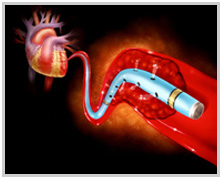The first catheterization of a human is attributed to Werner Forssmann 1929. Mason Sones, a pediatric cardiologist at the Cleveland Clinic accidentally injected contrast agent to right coronary artery while performing root aortography in 1958. The percutaneous approach that is widely used today was developed by Sven-Ivar Seldinger in 1953. By the late 1960s, Melvin Judkins had begun work on creating catheters that were specially shaped to reach the coronary arteries to perform selective coronary angiography. Catheters in these shapes carry his name and are still used to this day for selective coronary angiography.
 The use of a balloon-tipped catheter for the treatment of atherosclerotic vascular disease was first described by Charles Dotter and Melvin Judkins in 1964, when they used it to treat a case of atherosclerotic disease in the superficial femoral artery of the left leg. Building on their work and his own research involving balloon-tipped catheters, Andreas Gruentzig performed the first successful percutaneous transluminal coronary angioplasty (known as PTCA or percutaneous coronary intervention (PCI)) on a human on September 16, 1977 at University Hospital, Zurich. The use of a balloon-tipped catheter for the treatment of atherosclerotic vascular disease was first described by Charles Dotter and Melvin Judkins in 1964, when they used it to treat a case of atherosclerotic disease in the superficial femoral artery of the left leg. Building on their work and his own research involving balloon-tipped catheters, Andreas Gruentzig performed the first successful percutaneous transluminal coronary angioplasty (known as PTCA or percutaneous coronary intervention (PCI)) on a human on September 16, 1977 at University Hospital, Zurich.
The first intracoronary stents were successfully deployed in coronary arteries in 1986. The first stents used were self-expanding Wallstents. Stent technology improved rapidly, and in 1989 the Palmaz-Schatz balloon-expandable intracoronary stent was developed.
By the late 1990s it was generally acknowledged among cardiologists that the incidence of in-stent restenosis was between 15 and 30%, and possibly higher in certain subgroups of individuals. Stent manufacturers experimented with a number of chemical agents to prevent the neointimal hyperplasia that is the cause of in-stent restenosis.
One of the first products of the new focus on preventing late events (such as in stent restenosis and late thrombosis) was the heparin coated Palmaz-Schatz stent. These coated stents were found to have a lower incidence of subacute thrombosis than bare metal stents.
At approximately the same time, Cordis (a division of Johnson & Johnson) was developing the Cypher stent, a stent that would release sirolimus (a chemotherapeutic agent) over time.
Concurrent with the development of the Cypher stent, Boston Scientific started development of the Taxus stent. The Taxus stent was the Express2 metal stent, which was in general use for a number of years, with a copolymer coating of paclitaxel that inhibited cell replication.
By the end of 2004, drug eluting stents were used in nearly 80 percent of all percutaneous coronary intervention.
Before 1989 all coronary and non coronary procedures were performed by default femoral approach. But it is frequently associated with entry site complications. So, the search for a alternative site was going on. Theoretically the radial artery seems to be the most suitable alternative site of entry, because of its superficial location, easy hemostatic technique, almost no entry site complication and early ambulation after the procedure. In 1989, Lucien Campeau first performed successful coronary angiography by radial approach. Three years later in 1992, Ferdinand Kiemeneji first reported a series of cases of coronary angioplasty performed by radial approach. A popular newspaper heading at that time was "Treating heart disease through the wrist!". Since then it has gained progressive widespread acceptance in all over the world as the primary route for endovascular interventions. |
